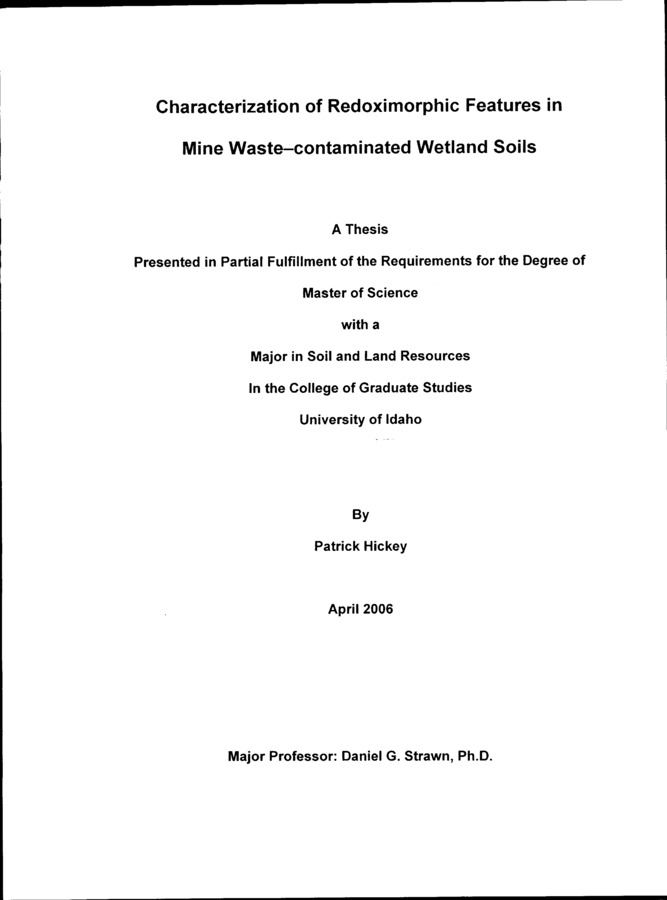PDF
Characterization of deoximorphic features in mine waste-contaminated wetlands soils Item Info
- Title:
- Characterization of deoximorphic features in mine waste-contaminated wetlands soils
- Authors:
- Hickey, P.
- Contributors:
- Idaho Water Resources Research Institute; IWRRI
- Date:
- 2006-04
- Description:
- Metal contamination from Northern Idaho mining operations has impacted wetlands along the Coeur d'Alene River floodplains resulting in a potentially hazardous environment for humans and animals. Contamination in these areas is often reported as total contaminant concentration per mass of soil, and assumes that the contaminants are homogenously distributed throughout the soil. However, pedogenesis causes distinct secondary mineral redistribution within soil profiles, and leads to selective partitioning of contaminants within the profile at macro (em) to sub-micron scales. This study examined the variability of redoximorphic features within a wetland, and contaminant enrichment in redoximorphic features relative to landscape position and water table height. Six distinct categories of Fe and Fe/Mn-rich cemented redoximorphic features were identified. The Fe and Fe/Mn-cemented redox features were found to have Cd and Pb concentrations up to four and six times greater in magnitude than soil averages. Iron and Fe/Mn-cemented redox features also had elevated levels of As and Zn. The Fe/Mn-cemented aggregates had the highest Mn concentrations (approximately 3.4%), were most common in the 1-2 mm size fraction, and contained the highest concentration of Pb (approximately 2.6%). Iron-cemented root channel linings and Fe-cemented aggregates had comparable concentrations of As, Cd, Mn, Pb, and S. Coarse sand aggregates and Fe/Mn-cemented aggregates had similar concentrations of Cd, Mn, P, and Zn. Iron-cemented aggregates and cemented root channel linings had physical similarities, while coarse sand aggregates and Fe/Mn-cemented aggregates also appeared similar. The Fe and Fe/Mn-cemented redox features were found primarily in the top 15 em of soil and decreased with soil depth. Results from this study show that pedogenesis in Coeur d'Alene wetland soils results in distinct redoximorphic features and non-homogeneous metal concentrations. Among these features are Fe and Mn - cemented aggregates that range in size from 1 to 2 mm in diameter. These aggregates have unique mineralogy and concentrate metals within the soils. Understanding contaminant partitioning and speciation in soils will allow for improved management and risk assessment of the contaminated soils.
- Subjects:
- heavy metals groundwater contamination speciation mineralogy
- Location:
- Coeur d'Alene River
- Idaho County:
- Shoshone County
- Latitude:
- 47.51
- Longitude:
- -116.15
- Collection:
- Coeur d'Alene Basin
- Source:
- University of Idaho
- Publisher:
- University of Idaho
- Contributing Institution:
- University of Idaho
- Type:
- Text
- Format:
- application/pdf
- Cataloger:
- wbv
- Date Digitized:
- 2012
- Language:
- eng
Source
- Preferred Citation:
- "Characterization of deoximorphic features in mine waste-contaminated wetlands soils", Idaho Waters Digital Library, University of Idaho Library Digital Collections, https://www.lib.uidaho.edu/digital/iwdl/items/iwdl-cda_hickey_2006.html
Rights
- Rights:
- In copyright, educational use permitted. Educational use includes non-commercial reproduction of text and images in materials for teaching and research purposes. For other contexts beyond fair use, including digital reproduction, please contact the University of Idaho Library Special Collections and Archives Department at libspec@uidaho.edu. The University of Idaho Library is not liable for any violations of the law by users.
- Standardized Rights:
- http://rightsstatements.org/vocab/InC-EDU/1.0/

